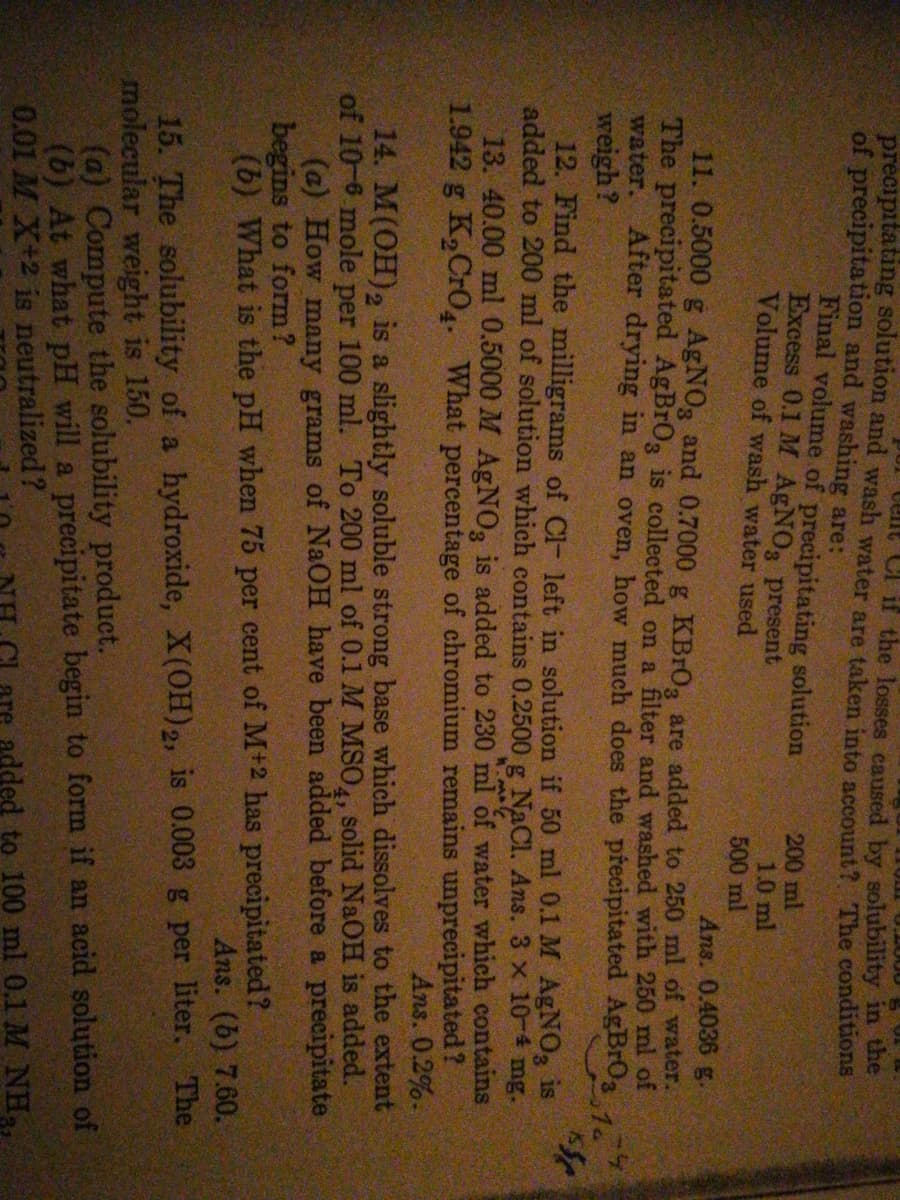UI Wash water used 500 ml Ans. 0.4036 g. Og and 0.7000 g KBrOa are added to 250 ml of water. BrOg is collected on a filter and washed with 250 ml of g in an oven, how much does the precipitated AgBrO3 3.
UI Wash water used 500 ml Ans. 0.4036 g. Og and 0.7000 g KBrOa are added to 250 ml of water. BrOg is collected on a filter and washed with 250 ml of g in an oven, how much does the precipitated AgBrO3 3.
Chapter16: Applications Of Neutralization Titrations
Section: Chapter Questions
Problem 16.40QAP
Related questions
Question
Questions number 11.12.13

Transcribed Image Text:vunt Cl if the losses caused by solubility in the
precipitating solution and wash water are taken into account? The conditions
of precipitation and washing are:
Final volume of precipitating solution
Excess 0.1 M AgNO3 present
Volume of wash water used
200 ml
1.0 ml
500 ml
Ans. 0.4036 g.
11. 0.5000 g AgNO3 and 0.7000 g KBRO, are added to 250 ml of water.
The precipitated AgBrO3 is collected on a filter and washed with 250 ml of
water. After drying in an oven, how much does the precipitated AgBrOs 1.7
weigh?
12. Find the milligrams of Cl- left in solution if 50 ml 0.1 M AgNO3 is
added to 200 ml of solution which contains 0.2500 g NaCl. Ans. 3 x 10-4 mg.
13. 40.00 ml 0.5000 M AgNO, is added to 230 ml of water which contains
1.942 g K,CrO4. What percentage of chromium remains unprecipitated?
Ans. 0.2%.
14. M(OH), is a slightly soluble strong base which dissolves to the extent
of 10-6 mole per 100 ml. To 200 ml of 0.1 M MSO,, solid NaOH is added.
(a) How many grams of NAOH have been added before a precipitate
begins to form?
(b) What is the pH when 75 per cent of M+2 has precipitated?
Ans. (b) 7.60.
15. The solubility of a hydroxide, X(OH)2, is 0.003 g per liter. The
molecular weight is 150.
(a) Compute the solubility product.
(b) At what pH will a precipitate begin to form if an acid solution of
0.01 M X+2 is neutralized?
added to 100 ml 0,1 M NH,
Expert Solution
This question has been solved!
Explore an expertly crafted, step-by-step solution for a thorough understanding of key concepts.
Step by step
Solved in 3 steps with 3 images

Knowledge Booster
Learn more about
Need a deep-dive on the concept behind this application? Look no further. Learn more about this topic, chemistry and related others by exploring similar questions and additional content below.Recommended textbooks for you


Principles of Modern Chemistry
Chemistry
ISBN:
9781305079113
Author:
David W. Oxtoby, H. Pat Gillis, Laurie J. Butler
Publisher:
Cengage Learning

Chemistry by OpenStax (2015-05-04)
Chemistry
ISBN:
9781938168390
Author:
Klaus Theopold, Richard H Langley, Paul Flowers, William R. Robinson, Mark Blaser
Publisher:
OpenStax


Principles of Modern Chemistry
Chemistry
ISBN:
9781305079113
Author:
David W. Oxtoby, H. Pat Gillis, Laurie J. Butler
Publisher:
Cengage Learning

Chemistry by OpenStax (2015-05-04)
Chemistry
ISBN:
9781938168390
Author:
Klaus Theopold, Richard H Langley, Paul Flowers, William R. Robinson, Mark Blaser
Publisher:
OpenStax

Chemistry & Chemical Reactivity
Chemistry
ISBN:
9781337399074
Author:
John C. Kotz, Paul M. Treichel, John Townsend, David Treichel
Publisher:
Cengage Learning